Atlanta Braves August deals that mattered: Julio Franco
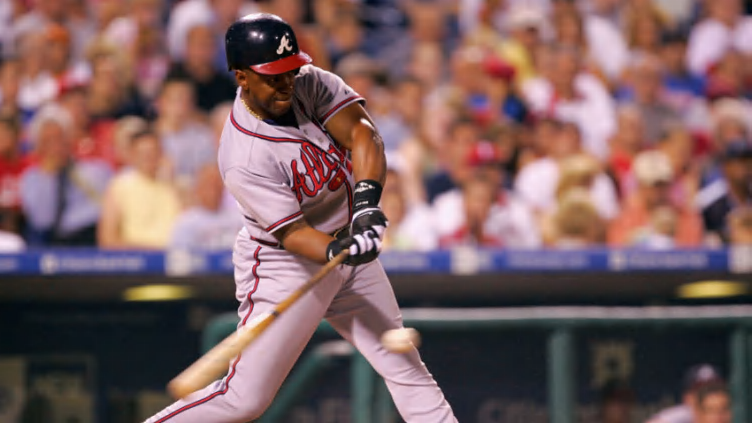
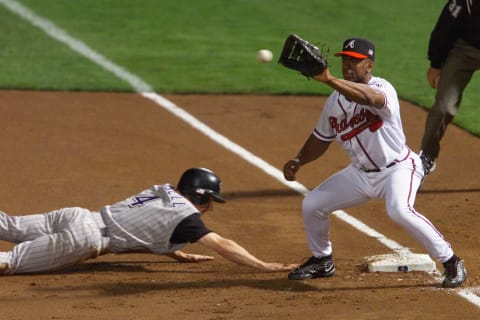
During the 15 seasons known as “The Streak” the Atlanta Braves made quite a few last minute additions to bolster their postseason chances.
Fred McGriff’s name is firmly etched as one of those players who made a difference for the Atlanta Braves but in 2001 it was another first baseman who reinforced the ranks: Julio Franco.
Watching an Atlanta Braves game early this week and following Twitter as well, I saw some Twitter critter ask if the Braves had claimed Julio Franco off waivers. It wasn’t mean but I realized there are a lot of Braves fans who don’t remember what he meant to the Braves from August 2002 through the 2005 season.
After he joined the Braves I became fascinated with the way he played the game. Franco the player always wore a huge smile when he played, enjoying every minute of it. Franco the hitter always seemed likely to deliver a game-winning hit.
His bat looked like a small tree, yet even at 44 years old he was lightning quick through the zone and could turn on anyone’s fastball. He drove the ball all over the field and hit it with authority in spite of having a stance that made hitting coaches cringe.
Here’s a reminder of his career in general and his short but important period with the Atlanta Braves
The batman begins
The Phillies signed Julio Franco as an international free agent in 1978. He first appeared in the Major Leagues in 1982 and later that year became one of six players traded to the Indians for Von Hayes. In 1983 he finished second in AL Rookie of the Year voting to Ron Kittle.
Kittle’s career ended 10 years later, never again approaching the 1.9 bWAR (2.9 fWAR) he generated his rookie year. Franco took a different path.
From 1983 through 1991 playing shortstop and second base, first for Cleveland and later for the Rangers, Franco amassed 1597 hits, posted a .302/.360/.411/.771 line that included 241 doubles, 40 triples, and 84 home runs, stealing 219 bases and accumulating 32.1 bWAR (31 fWAR). That puts Franco in some pretty elite company (tables sorted on OPS.)
Provided by Baseball-Reference.com: View Play Index Tool Used
All of the players ahead of him except Lou Whitaker are now in the Hall of Fame.
Franco won the AL batting title in 1991, with a .341/.408/.474/.882 line, a .393 wOBA,146 wRC+, and posted 6.2 bWAR (5.9 fWAR).
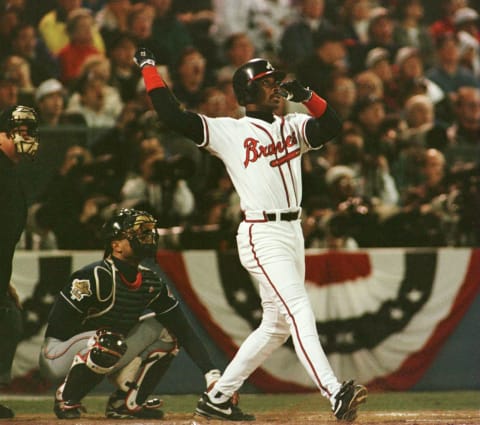
The wandering hitting savant
Injury limited Franco to 35 games in 1992 and he struggled in 1993. In 1994 Franco moved to Chicago and hit to a .319/.406/.510 line with a .398 wOBA and 141 wRC+ for the Sox in 112 games before the strike ended the season.
Nothing stood in the way of Franco playing baseball and as the strike drug into 1995, free agent Franco went to Japan playing for Chiba Lotte. He returned in 1996 at the age of 38 to play for the Indians once more and hit .322/407/.470/.877 with a .387 wOBA and 124 wRC+.
He struggled in 1997, mostly due to injury, and no one wanted him in 1998 so he returned to Japan and once again posted strong numbers. The Rays signed him in 1999 but after one game they released him.
The next two years saw Franco play in Mexico, Korea and then back in Mexico.
Who’s on first?
Since acquiring McGriff at the deadline in 1993, the Atlanta Braves came to expect consistently high production at that first base position. From 1993 through 1997 McGriff compiled a .293/.369/.516/.885 line even though his personal OPS dipped to .797 in 1997.
Andrés Galarraga followed McGriff in 1998 and posted a .991 OPS. While “The Big Cat” fought and beat cancer in 1999, Ryan Klesko, Randall Simon, and Brian Hunter turned in a combined .843 OPS. Galarraga returned in 2000 to restore order with another super year and a .895 OPS. In 2001 all of those players were gone.
The Braves brought in Rico Brogna but back injuries hobbled him and he managed just 72 games hitting .248/.297/.335/.632. His back hurt him too badly to allow him to play, so the Braves placed him on the 60-day DL and although he was just 31, he never played major league ball again.
Wes Helms played parts of 65 games at first, but he hit just .231/.297/.421/.718 while manning first base. Current Nationals manager Davey Martinez, then 36-years old and in his final Major League season, played a handful of games at first as well hitting .154/.214/.154/.368.
Clearly, this was not good enough to win a championship; the Braves needed a real first baseman.
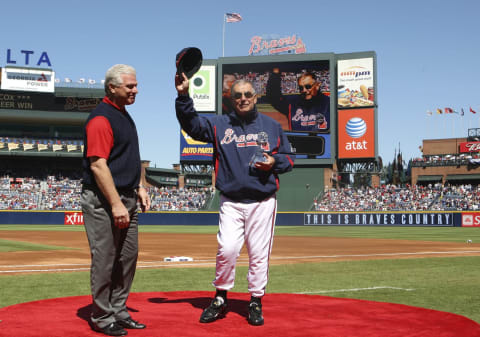
Moneyball was not created in Oakland
Most of us saw the movie and/or read the book putting for the concept that Moneyball somehow sprung from the seed of an empty ledger in Oakland and the chance hiring of a statistical analyst willing to tell a well-respected Major League GM where he was screwing up.
While the Athletics perhaps brought new twists to the idea, teams have always been looking for undervalued, underappreciated players and in 2001 the Braves had no choice. There weren’t any good options on the market and opposing teams were less than thrilled with the idea of helping the Braves continue to beat their brains out.
The Braves signed one-time Gold Glove third baseman and 1996 NL MVP Ken Caminiti after the Rangers released him in July. While Caminiti managed to hit six homers as Braves first sacker, he hit a puny .226/.320/.434/.754 and struck out 32 times in 106 AB.
Caminiti wasn’t the answer and they were running out of ideas when fortune – and staying on top of the business – paid off.
You want to sign who?
As then Atlanta Braves GM John Schuerholz explains it in “Built To Win,” Julio Franco became a member of the Braves because AGM Frank Wren read in Baseball America that Franco led the Mexican league in hitting. I couldn’t find the original article but saying he led the league in hitting actually understated Franco’s performance.
In 2001 Julio Franco seemed to have taken it upon himself to destroy Mexican League pitching – and he succeeded.
On August 30, 2001, Franco had a .417/.497/.678/1.175 line with 18 homers, 34 doubles, five triples and 90 RBI in 469 PA.
In any league those numbers deserve respect. After asking a few “are you sure you want to go there” internal questions, Schuerholz told Wren to get the whole story and as he recounted on pages 40 – 41 of the book, their questions drew enthusiastic responses.
. . .we sought (the opinion) of the opposition managers . . .Eddie Díaz, a friend and contact of Frank’s. When asked how (Franco) did against the top pitchers in that league, Díaz said, ”Julio hits everybody! He can still play. – He’s outstanding around first base and is in phenomenal condition.” The other recommendations were as strong, so we decided to go for it . . .”
Going for it worked out really well.

Franco on first
Franco played in 25 games for the Atlanta Braves that season hitting .300/.376/.444/.821 including three homers and four doubles to finish with a .357 wOBA and 116 wRC+.
He continued to play well in 3 NLDS games, hitting .308/.308/.538/.846 – including a homer off Shane Reynolds in game three. He followed that in five NLCS games against Arizona as well going 6 – 24.
Signing the 40-year old Franco was a success made all the more impressive when, following the post 9/11 validation of immigrant paperwork, they found Franco was actually 42.
The Braves brought him back for the 2003 season and continued to do so through 2005. In that span, Franco posted a .295/.367/.447/.817 line with 20 homers, 24 doubles six triples and eight stolen bases with a .352 wOBA and112 wRC+. One of those homers made history.
The Atlanta Braves suffered a large loss in revenue in the 2003 season and couldn’t match the offer of the New York Mets made after the 2005 season. Franco later told VICE sports he regretted signing with the Mets.
“Bobby Cox knew how to use me. I went to New York and sometimes I spent a month on the bench . . .you bring me in the ninth inning and think I’m going to drive in the winning run? And you were sitting me on the bench for 20 days, 15 days, 30 games without an at-bat? It’s not gonna happen.”
Did someone say records?
Julio Franco currently sits at #87 on the all-time hits list, with 2586 and his 407 doubles place him at #175. Franco is:
- The oldest player to hit a home run, May 4, 2007, at 48-years 254 days old. He’s also the second, third, fifth-through-nineteenth, twenty-fourth and twenty-fifth on the top 25 list.
Baseball-Reference’s play index tool tells us he’s close to the top of many lists of stats for players over 40.
- #7 for RBI — 213
- #8 for Doubles – 72
- #10 for Hits – 409
- #17 for homers – 32
- #22 for Triples – 8
- #59 for batting average – .285 Note that Ted Williams and Chipper Jones hit .287 after turning 40.
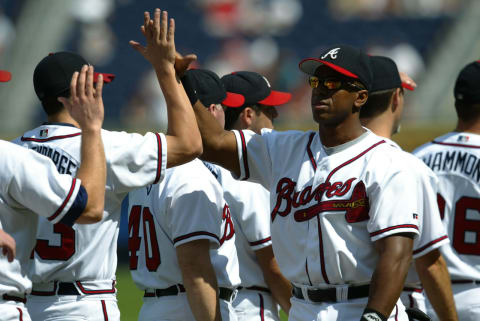
Epilogue
After being released by the Mets in July 2007, Franco rejoined the Atlanta Braves. Franco appears to have been correct about the Mets as he outperformed his early season numbers in New York once he returned to Atlanta. He recorded his last major league hit as a member of the Braves, a first pitch opposite field single that also produced his final Major League RBI.
Franco played his last Major League game on September 17, 2007, at the age of 49 years and 25 days. The Brewers signed him for 2008 but cut him before the end of spring training.
He played a few games back in Mexico during 2008 and in 2014 surfaced in Fort Worth as player/manager for the Cats in the United Baseball League. Following the 2015 season, he took over as manager for the Ishikawa Million Stars in a Japanese independent league.
According to a post by Parker White on 12 Up, and a more in-depth piece in The Athletic (subscription required), Franco moved to Korea to this season to coach the Lotte Giants in the Korean Baseball League (KBO.)
When Franco arrived in Atlanta, then Braves coach Ned Yost told Cox that Franco looked in better shape than anyone on the Braves. It appears he’s still a superb physical specimen.
White quotes Sung Min Kim in The Athletic speaking in superlatives about the 59-year-old manager.
Franco’s arms and chest are bigger than those of any (Lotte) Giants prospect he coaches. He still lifts (weights) five times a week.
“If I tell you that I’m going to play baseball again, would you believe me?” Coaching in South Korea, Julio Franco is still going strong, by @sung_minkim: https://t.co/e0ysq1OaVH
— The Athletic MLB (@TheAthleticMLB) July 12, 2018
According to White, Franco responded to a question by Kim about his physical condition like this.
“I gotta take care of this vessel,” Franco said. “This is where I’m spending all of my time. You got one life to live. If you don’t take care of your body when you’re young, believe me, it’s going to be too late when you’re old.”
That’s a wrap
Julio Franco celebrated his 60th birthday on Thursday. He was as unique a player as he is a man. He played the game because he loved the game. He continues to play and coach because he can’t imagine doing anything else.
My dad always said good hitters will always hit. I have no doubt Julio Franco could step to the plate today and get a hit. Franco was always the guy I wanted as Atlanta Braves hitting coach. No one knows more about the art of hitting and few used it as effectively as Franco in his prime.
Now that he’s not playing any longer, Franco could be back in the Dominican enjoying retirement. Instead, he spends his time coaching in the KBO’s low minor leagues when 50 fans are a crowd and the players are a long way from the big leagues.
Next. The top ten deals. dark
Happy belated birthday Julio. Thanks for being there when the Atlanta Braves needed you. I hope one day soon you’re back home helping young players learn to play the game the right way.